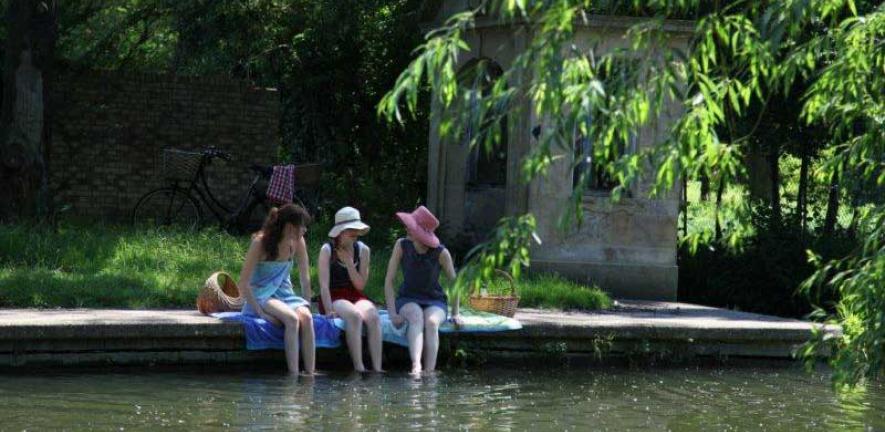
A walking tour of historic swimming spots taking place during Open Cambridge (7-9 September) will celebrate Cambridge’s shifting relationship with the river that flows through it. The tour is fully booked but the places it explores are accessible to the public.
A walking tour of historic swimming spots taking place during Open Cambridge (7-9 September) will celebrate Cambridge’s shifting relationship with the river that flows through it. The tour is fully booked but the places it explores are accessible to the public.
All summer, Sheep’s Green and Coe Fen were pink with boys, as naked as God made them; for bathing drawers did not exist then: or at least, not on Sheep’s Green.
Gwen Raverat, Period Piece (1952)
Nothing deters those determined to swim. The winter of 1928-1929 saw Britain in the grip of icy weather. Waterways all over the country were reported frozen and skaters took to ponds and rivers. The Cambridge News of 16 February 1929 reported in a jocular tone: ‘Eight hardy spirits took the plunge at the Town Bathing Sheds though it took nearly half an hour to break the ice. Many of them have hardly missed a day.’
The Town Bathing Sheds (wooden changing rooms built and maintained by the city corporation) which stood on Sheep’s Green have long been demolished along with the diving boards where local youngsters once performed spectacular swallow dives and daring somersaults. But along the banks of a half-mile stretch of the Cam, just upstream of the city, are small signs of a secret history of bathing that pre-dates the chlorine and concrete of municipal swimming pools.
In a walking tour taking place on 8 September as part of Open Cambridge, author and swimmer Jean Perraton will explore Cambridge’s historic bathing spots and look at the ways in which social attitudes shaped, and continue to shape, our enjoyment of rivers. In particular she will celebrate the joyful experience of swimming as “a chance to revel in the element that covers most of our planet” and look at the ways in which writers down the ages have drawn inspiration from the watery world.
Emmanuel and Christ’s Colleges have their own historic pools. But for centuries, until the public pool at Jesus Green was constructed in 1923, people swam in the River Cam. On a stretch of the river at Sheep’s Green, ten minutes’ walk from the city centre, in the 19th and much of the 20th century hundreds of local children took their first strokes in a side stream known at the Snobs.
“Children had to show they could swim confidently in the Snobs before they were allowed to swim in the main river where they would be out of their depth,” says Jean Perraton.
For more than 30 years swimming at Sheep’s Green was supervised by a man called Charlie Driver. He was custodian of the Sheds and a fine athlete who taught swimming and diving. Swimming galas and races took place on the river right up to the 1970s with one of the annual races being along the Backs right through the town and past many of the oldest colleges.
Next to the footbridge at Sheep’s Green is a little classical building in a walled garden. Hodson’s Folly was built in 1887 by local resident John Hodson so that he could keep a watchful eye on his daughters bathing in the river while overseeing his nearby fish hatchery. The land used was common land which Hodson, who was at one point a butler’s assistant at Pembroke College, had annexed without permission. As a speculative builder Hodson excelled: his building sports a coat of arms, showing a swan in a rain storm, and the summer house and its garden are in many ways a Cambridge college in miniature.
At the town bathing places men and women bathed at separate spots until well after the Second World War. Men and boys had long been able to swim on Sheep’s Green, but in 1896 the city authorities provided bathing sheds for women in a more secluded spot opposite Hodson’s Folly. The water there was never really deep enough but, although strong female swimmers were allowed to join the men earlier, it was not until 1966 that the Town Sheds became mixed.
All that remains of the Ladies Bathing Place today is a solitary handrail . While women bathed in voluminous costumes, before the 20th century it was usual for men and boys to swim naked. As Gwen Raverat (grand-daughter of Charles Darwin) described in Period Piece, her account of a Cambridge childhood in the 1890s: “All summer, Sheep’s Green and Coe Fen were pink with boys, as naked as God made them; for bathing drawers did not exist then: or at least, not on Sheep’s Green.”
While the men and boys of the town swam at the Town Sheds, pupils from the Perse and the Leys School had their own bathing places on the other side of the river. Further upstream is the site of the University’s bathing place (now a private club run by a committee). Beyond it the river dreamily runs through Grantchester Meadows where in the early 1900s a group of Cambridge undergraduates and their friends, dubbed the neo-Pagans, spent their summers bathing in the river and camping under the stars. Among them were Rupert Brooke and Virginia Woolf who are said to have swum naked by moonlight at Byron's Pool, a place that’s disappointingly unromantic today with the M11 roaring past.
In a memoir published in 1935 the novelist Rose Macaulay, whose father was a Fellow of Trinity College, captured the sensuous pleasure of swimming in nature early one spring morning upstream of the city. She wrote: “I let the slow flow carry me gently along through shadow and light, between long weedy strands that slimily embrace me as I drift by, between the bobbing white and gold cups and the slippery juicy stems, between willows that brush my head with light leaves, beneath banks massed high with may, smelling sharp and sweet above the musky fragrance of the tall cow-parsley.”
The early history of swimming is shrouded in mystery. While swimming was seen as a useful military skill, it’s thought that few people in Britain were good swimmers before the 16th century. The danger of venturing into deep water prompted the Vice-Chancellor of the University of Cambridge in 1571 to forbid undergraduates from entering the water: “..if any scholar should go into any river, pool or other water in the county of Cambridge, by day or night, he should .. be sharply and severely whipped publicly…”
But a change of attitude was afoot. In 1587 Everard Digby, a Fellow of St John’s College, published a treatise on swimming called De Arte Natandi (the Art of Swimming). Written in Latin, its purpose was to raise swimming from “the depth of ignorance and the dust of oblivion”. A few years later Christopher Middleton, also a scholar from St John’s, published a shorter version of Everard’s opus in English. A section devoted to practical tips advises against swimming when rain is washing dung into the water; a section on how to swim describes how to cut one’s toe nails while floating.
Many more books giving advice on swimming were published in the following two centuries, no doubt boosted by the discovery of the joys of sea bathing. Although the seaside became more accessible with the expansion of the railways in the mid-19th century, and then swimming baths and lidos became more widely available, river swimming – in the Cam as elsewhere – remained immensely popular.
The final years of the 20th century saw the closure of many outdoor swimming pools and increasing discouragement of swimming in rivers and lakes. But the past ten years have witnessed a quiet revolution as growing numbers of people have rediscovered the pleasures of swimming in rivers and lakes. Roger Deakin’s Waterlog (Chatto and Windus, 1990), an eclectic account of a swimming journey across Britain, lit the flame for a surge of books and films and inspired the formation of countless groups and websites.
Jean Perraton adds: “In the later years of the 20th century official concerns about pollution increased, just as the river was getting cleaner, and Cambridge City Council’s practical support for swimming in the river turned to active discouragement. The Cam Conservator’s byelaws forbade swimming except at official bathing places – but by then there were none left. Now, the Conservators have agreed that the whole of the upper river, from the Mill Pond to Byron’s Pool, can be regarded as a bathing place. Now that wild swimming has become cool, more and more people are discovering, or re-discovering, this most simple and delightful of summer pleasures.”
Jean Perraton is author of Swimming Against the Stream (Jon Carpenter Publishing, 2005, available from bookshops or Amazon.
There are places still available for some Open Cambridge events – including a talk about Cambridge’s Civic Insignia and Historic Charters, tour of the English Faculty Library and tour of New Hall Art Collection. For details of how to book go to /open-cambridge. Some events are drop-in with no need to book.
This work is licensed under a Creative Commons Licence. If you use this content on your site please link back to this page.





